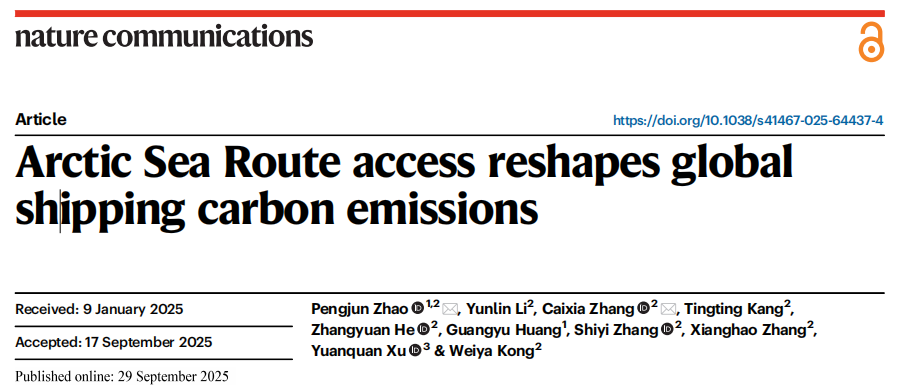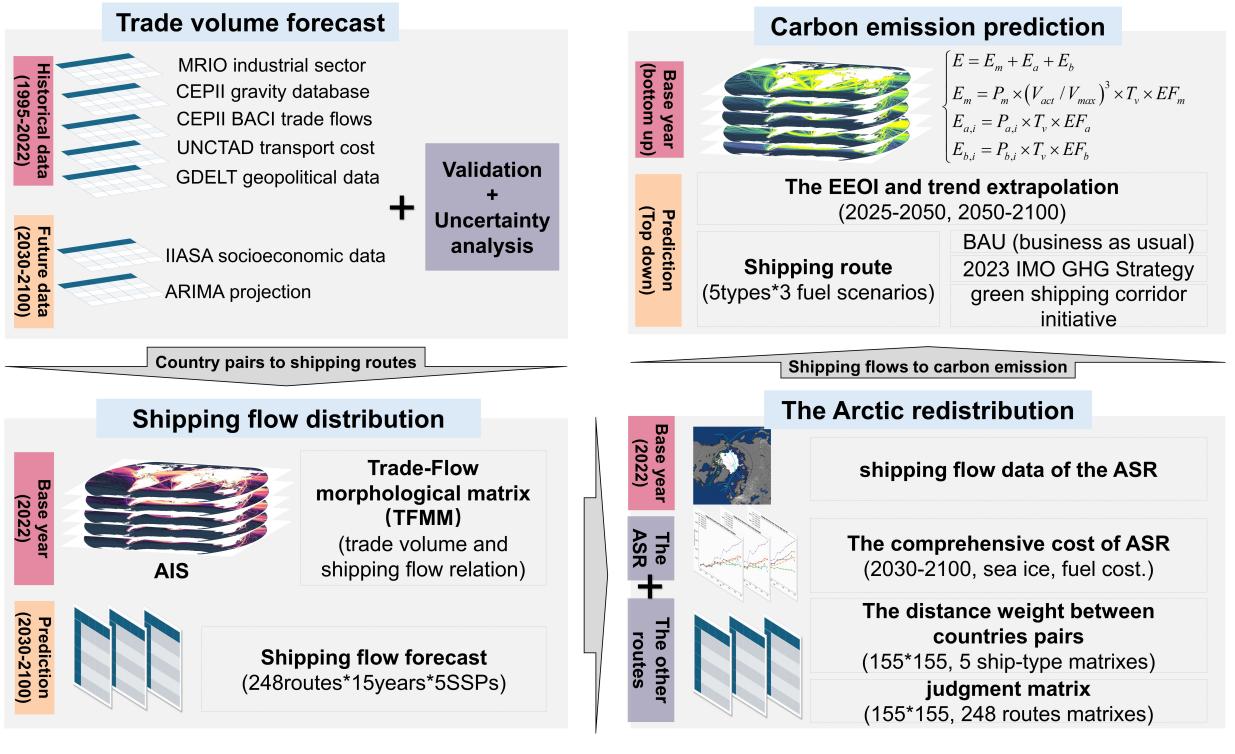
Maritime shipping carries about 80% of global trade, serving as the lifeline of the world economy, a strategic arena of great-power competition, and a frontier topic in transport geography and regional planning. In recent years, under the dual influence of climate change and shifting geopolitical dynamics, the Arctic Sea Route (ASR) has emerged as a new global maritime focus.
A research team led by Professor Pengjun Zhao from Peking University—supported by the National Science Fund for Distinguished Young Scholars and its extension project—developed an integrated Trade–Shipping–Emission Prediction (TISEP) modeling framework (Figure 1). Using 649 million AIS ship-position records, multi-source trade big data, and Arctic oceanic–meteorological datasets, the model precisely simulates the complex Earth–human system interactions across multiple scales, including climate change, Arctic ice conditions, global trade flows, ship routing behaviors, and maritime carbon emissions.
The study identifies the opening patterns of Arctic routes and quantifies their impacts on global shipping networks and carbon emissions, proposing and testing net-zero decarbonization strategies for Arctic navigation. The results offer new empirical evidence for Arctic route planning, provide a basis for global governance of Arctic shipping, and pioneer a big-data and systems-modeling paradigm for transport geography. The study also advances cross-disciplinary research integrating transportation, oceanography, and atmospheric sciences.
Notably, the proposed “Arctic Net-Zero Strategy” introduces a Chinese perspective on a systematic and globally applicable path toward carbon-free maritime development, offering actionable policy insights for international decarbonization efforts.
Innovative TISEP Framework
The TISEP model integrates global trade, shipping routes, and emissions into a unified predictive framework capable of simulating the coupled effects of route optimization, ship energy structures, and policy interventions. Its dynamic adaptability allows the incorporation of macroeconomic, geopolitical, and climatic uncertainties, providing a robust tool for assessing carbon shifts and environmental risks under Arctic shipping development.
This framework offers forward-looking theoretical support and practical pathways for international maritime decarbonization policies and Arctic environmental governance, serving as an important reference for regional cooperation and policymaking within global climate governance systems.

Figure 1: Integrated Trade–Shipping–Emission Prediction (TISEP) framework.
Key Findings
1. Arctic Navigability Will Expand Dramatically
Under the medium-emission scenario (SSP2-4.5), the Arctic’s navigable potential will steadily increase throughout the 21st century (Figure 2).
·By 2030, the Arctic will be navigable for 197 days per year on average.
·By 2050, this extends to 208 days, by 2070 to 217 days, and by 2100, to 247 days.
·Under a high-emission scenario (SSP5-8.5), navigable days could exceed 320 days annually.
Improvements are not limited to time but also to spatial accessibility. Simulations of sea-ice thickness, concentration, and drift indicate that during spring and summer seasons, particularly in September, vast Arctic waters will transition from “icebreaker-required” to “ice-free navigable”, highlighting the profound impact of climate change on Arctic sea-ice retreat.

Figure 2: Predicted Arctic navigability under Shared Socioeconomic Pathway 2 (SSP2).
2. Arctic Shipping Will Reshape Global Trade Flows
As the Arctic opens, global maritime patterns will undergo a historic transformation.
·By mid-century, voyages through the Northeast Passage are expected to exceed 20,000 annually—a tenfold increase from today’s level.
·By 2070, the Northwest and Central Arctic Routes will also see rapid growth.
·By 2100, the Arctic Sea Route is projected to support year-round navigation, accounting for over 2% of global shipping, rivaling the Suez and Panama Canals as a major global corridor.
The Bering Strait will emerge as a core hub linking East–West trade. By 2100, oil and gas carriers will represent 60–70% of Arctic traffic, underscoring its growing role in global energy trade.

Figure 3: Evolution of global shipping flows under Arctic route development (2022–2100).
3. Arctic Routes Will Reshape Global Carbon Emission Geography
While Arctic routes shorten sailing distances and reduce per-voyage emissions, the surge in traffic will drive regional emissions upward.
By 2100, Arctic-region maritime emissions are projected to exceed 2% of the global total, ranking among the top five emission corridors worldwide (Figure 4).
The redistribution of global shipping carbon emissions will create new geographic imbalances:
·Northeast Asia, Northern Europe, and North America will experience greater emission pressures,
·while traditional chokepoints such as the Suez Canal and Strait of Malacca may see slight relief.
Overall, the opening of the Arctic will reconfigure the global maritime carbon landscape, challenging international climate equity and emission reduction targets.

Figure 4: Global maritime carbon redistribution caused by Arctic route opening (2025–2100).
Net-Zero Strategy: A Chinese Contribution to Global Maritime Decarbonization
To address the carbon risks of Arctic shipping, the team designed and simulated three decarbonization pathways:
1.IMO 2023 Strategy,
2.Green Corridor Strategy, and
3.the newly proposed “Arctic Net-Zero Strategy.”
The Net-Zero Strategy introduces the concept of “zero emissions at the point of combustion”, requiring ships to achieve absolute zero emissions during fuel use—distinct from current lifecycle-based accounting methods. This principle promotes the adoption of electric, hydrogen, and nuclear propulsion technologies in global shipping.
The strategy follows a phased implementation:
·Phase I: achieve net-zero emissions in ecologically fragile and climate-sensitive Arctic regions first,
·Phase II: expand to major global maritime networks.
This “strict fuel standard + regional-first implementation” approach closes systemic loopholes in partial decarbonization and provides a scientifically grounded and operational blueprint for achieving global maritime decarbonization within this century.
Simulation results show that under IMO 2023 and Green Corridor strategies, carbon rebound effects persist—reductions in some regions are offset by increases elsewhere (Figure 5). In contrast, the Net-Zero Strategy achieves over 90% cumulative emission reductions, fully offsetting additional emissions from route restructuring and achieving complete Arctic decarbonization before 2100.

Figure 5: Global shipping carbon impacts under different mitigation strategies (2025–2100).
Publication Information
The study, titled “Arctic Sea Route reshapes global shipping carbon emissions,” was published online in Nature Communications on September 29, 2025.
Professor Pengjun Zhao (Peking University) serves as first and corresponding author, and Associate Researcher Caixia Zhang is co-corresponding author.
The work was supported by the National Natural Science Foundation of China (Grants 42525101, 42130402).
Read the full article:
https://www.nature.com/articles/s41467-025-64437-4